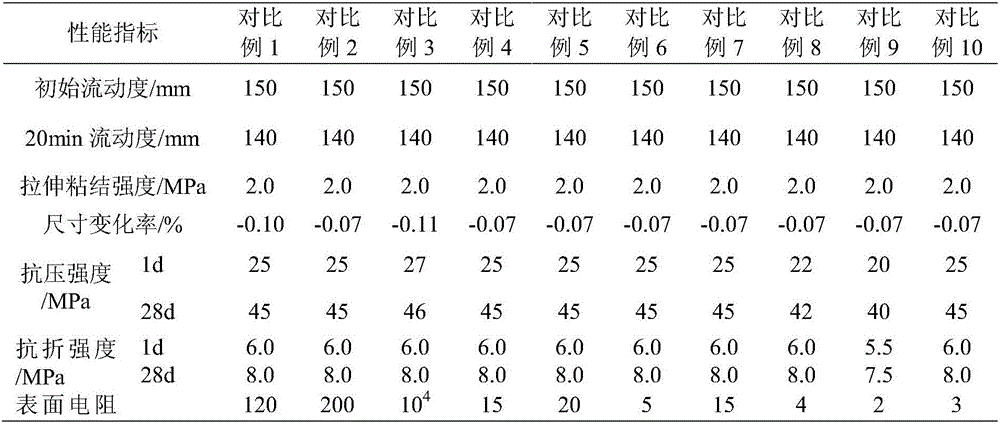Cement-based self-leveling antistatic terrace material
A floor material and self-leveling technology, applied in the field of building materials, can solve the problems of non-wear resistance, large amount of antistatic fillers, poor floor strength, etc., achieve small impact, improve shrinkage cracking resistance, and use less Effect
- Summary
- Abstract
- Description
- Claims
- Application Information
AI Technical Summary
Problems solved by technology
Method used
Image
Examples
Embodiment 1
[0020] A cement-based self-leveling antistatic floor material, comprising the following components calculated by weight ratio: 15 parts of aluminate cement, 20 parts of ordinary Portland cement, 3 parts of fly ash, 1 part of slag, cooked 1 part of gypsum, 1 part of ethylene / vinyl acetate copolymer latex powder, 0.4 part of silicone defoamer, 1 part of polycarboxylate superplasticizer, 56.05 parts of quartz sand, copper fiber (diameter 5 μm, length 0.5 cm ) 0.05 parts, copper powder (200 mesh) 1.5 parts. Weigh each component according to the weight ratio, add water and stir evenly after mechanical mixing; then pour the ground, self-leveling molding, and solidify into a ground material. The weight ratio of floor material to water is 1:0.15. The performance test is shown in Table 1.
Embodiment 2
[0022] A cement-based self-leveling antistatic floor material, comprising the following components calculated by weight ratio: 25 parts of aluminate cement, 10 parts of ordinary Portland cement, 1 part of fly ash, 3 parts of slag, cooked 3 parts of gypsum, 0.5 part of vinyl acetate / ethylene tertiary carbonate copolymer latex powder, 0.8 part of polyacrylic acid defoamer, 0.5 part of polycarboxylate superplasticizer, 54.0 parts of quartz sand, stainless steel fiber (diameter 30 μm, length 2cm ) 0.2 parts, stainless steel powder (800 mesh) 2 parts. After weighing and mixing according to the above weight ratio, add water and stir evenly before construction and use. The weight ratio of floor material to water is 1:0.25. The performance test is shown in Table 1.
Embodiment 3
[0024] A cement-based self-leveling antistatic floor material, comprising the following components calculated by weight ratio: 20 parts of aluminate cement, 20 parts of ordinary Portland cement, 2 parts of fly ash, 2 parts of slag, cooked 2 parts of gypsum, 0.8 part of acrylic polymer latex powder, 0.5 part of silicone defoamer, 0.5 part of polycarboxylate superplasticizer, 49.1 parts of quartz sand, 0.1 part of carbon fiber (diameter 10 μm, length 1 cm), conductive Muscovite (600 mesh) 3 parts. After weighing and mixing according to the above weight ratio, add water and stir evenly before construction and use. The weight ratio of floor material to water is 1:0.20. The performance test is shown in Table 1.
PUM
| Property | Measurement | Unit |
|---|---|---|
| diameter | aaaaa | aaaaa |
| length | aaaaa | aaaaa |
| particle diameter | aaaaa | aaaaa |
Abstract
Description
Claims
Application Information
 Login to View More
Login to View More - R&D
- Intellectual Property
- Life Sciences
- Materials
- Tech Scout
- Unparalleled Data Quality
- Higher Quality Content
- 60% Fewer Hallucinations
Browse by: Latest US Patents, China's latest patents, Technical Efficacy Thesaurus, Application Domain, Technology Topic, Popular Technical Reports.
© 2025 PatSnap. All rights reserved.Legal|Privacy policy|Modern Slavery Act Transparency Statement|Sitemap|About US| Contact US: help@patsnap.com



